Marital Rape Epidemic in India
July 23, 2016 3 Comments
Off late there has been a lot of discussion on Marital Rape. Rape is defined as, ‘Any Sexual intercourse without ones consent’. Rape is a deplorable act, within marriage or outside of it. Before we delve deeper into the discussion on rape, lets understand some statistics on it:
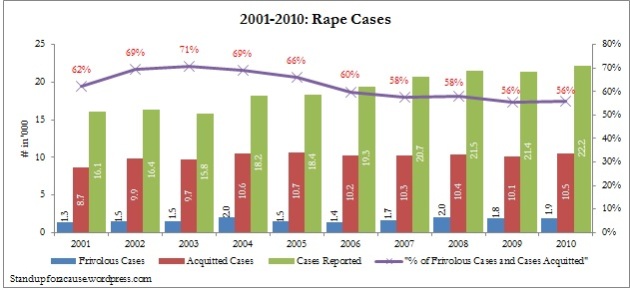
As we can see in the chart above whopping over 60% of all report rape cases are frivolous and donot stand the test of trial. Even organizations working for the cause of women have realized the gravity and extent of false accusations of rape. They have stated that over 53% cases filed were found to be false and ‘revenge was the motive of filing false cases’.
Presently in India, one false rape accusation from a woman makes the man a criminal, one accusation destroys his career and one accusation drains out his savings on legal recourse for defending himself. The woman gets a public prosecutor (ie. an attorney appointed by the state to fight the case on her behalf). There is no accountability whatsoever for filing a frivolous complaint by the woman primarily because of –
- Her identity being protected, therefore filing a frivolous complaint has no public backlash. Whereas the accused’s life is destroyed due to her frivolous complaint. No wonder the Indian Courts have stated that the victim of false case should be called a ‘rape case’ survivor
- As a public prosecutor is provided to the woman, there is no financial drain on her resources
- There are hardly any consequences for filing a false rape case.
Let us now understand the problems in the current rape laws:
- As shown in the data above it has become increasingly easy to level a false complaint for rape.
- There are no consequences for filing false complaints.
- The falsely accused person stands to lose everything due to the false case
- Men who are raped by women cannot file any complaint of rape. Their bodily integrity is not recognised by law
The need of the hour currently is to immediately amend the rape laws to:
- Make them ‘Gender Neutral’, like in many other western countries where men can also file rape cases. As per a UK study substantial number of men were victims of rape.
- Protecting the identity of the rape accused until the conviction, to protect him from media trials as there is a high probability that the case against him would be false as shown in the data above
- Making the identity of the women public post trial, if the case if found to be frivolous, so as to prevent false cases being filed for ulterior motives
- Compulsorily trying the woman for ‘malicious prosecution’ and ‘perjury’ for filing false complaint, and ruining the life of the ‘Rape Case Survivor’
- Rehabilitation and compensation of ‘Rape Case Survivors’
Now as the foundation is clear, we can proceed to discussion on Marital Rape. The reasons put forward to pass a marital rape law are as under:
- There are no Marital Rape Laws in India: This statement is false, as per The Protection of Women from Domestic Violence Act, 2005 (DV Act), section 3, defines ‘Sexual Abuse’ to include any conduct of a sexual nature that abuses, humiliates, degrades or otherwise violates the dignity of woman. Therefore any woman subjected to sexual abuse such as marital rape can get orders under the DV Act.
- Over 60% of Indian Women are subjected to Marital Rape: This is a generally quoted statistic that over 60% of Indian Women are subjected to marital rape. The base of this statistic is on a UNFPA report (Violence Against Women in India, 2004) which bases its comments on a report titled, Population Reports – Ending Violence Against Women, 1999 and this report bases its comments from a report Sexual violence within marriage: a case study of rural Uttar Pradesh, 1997. This study interviewed 115 women from a rural village in Uttar Pradesh. About 76 of these women knew nothing about sexuality during marriage. In most cases the first sexual encounter was characterized by male sexual coercion and female submission. This is being classified as Marital Rape epidemic in India.
Let’s understand the concerns in this report:
- The sample size is 115 rural women from Uttar Pradesh in 1997. This is not representative of the population of India and also is inappropriate be used after 20 years.
- The above women had no clue about sex at the time of marriage, therefore their husbands would have persuaded them to consummate the marriage which could have been classified as marital rape. The most logical transaction between the newly wed couple would have been:
“You’ll really enjoy it Mary.”
“Be careful, Patrick. Don’t.” No, you mustn’t.” “Oh. Oh. Not so hard.” “Do it gently. Oh yes, that’s better. Yes, that’s nice. Do it that way.”
- Gender Neutral Rape and Marital Rape Laws: The proponents of marital rape law shy away on the request to make the law gender neutral. They know that majority of domestic violence across the world is initiated by women. Making a gender neutral law would bring out all the atrocities faced by men at the hands of women in a domestic setting. Why are the proponents shying away from making a gender neutral law?
- Strict provisions for False Accusations: Again the proponents are shying away from adding strict provisions for false accusation and consequences for filing a frivolous case. We have seen how grossly misused are the other women specific laws including the rape laws. Why do the proponents shy away from protecting the identity of the rape accused until the conviction to protect him from media trials?
- Women do not lie about rape: This statement is completely false. As can be seen above majority of the rape cases are found to be frivolous / false. As per women’s organizations over 53% cases filed were found to be false and ‘revenge was the motive of filing false cases’. There have been cases where a 75 year old sick frail old man, who could not even stand straight was booked for raping a young lady in mid-thirties. The slapping the false rape was to merely extract money from the man. Another example of false case can be found here.
- Jurisprudence Provisions: No discussion ever takes place on the detailed jurisprudence on marital rape laws, safeguards to be employed to protect the falsely accused and evidence requirements. A law without safeguard mechanisms is a bound to be bane on the society.
As we can see above the whole debate on marital rape is hollow as adequate protection is available for women from marital rape. It is the men who need protection from false cases, domestic violence and marital rape which is being conveniently brushed under the carpet.
Let us all Stand Up for a Cause…
———————–
Chart data Source: NCRB – Frivolous Cases includes: a) Cases compounded or withdrawn, b) cases declared false on account of mistake of fact or of law, c) cases not investigated or in which investigation was refused, d) cases withdrawn by the govt., and e) cases withdrawn by the govt. during investigation.
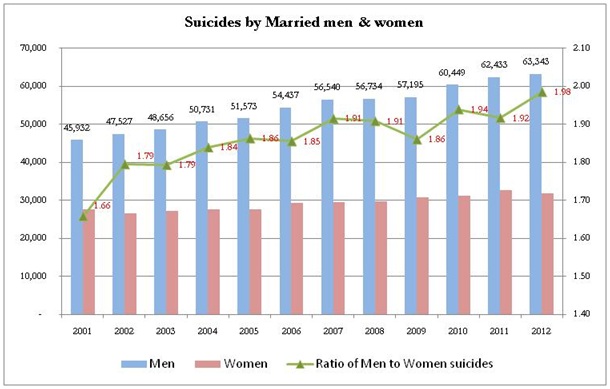



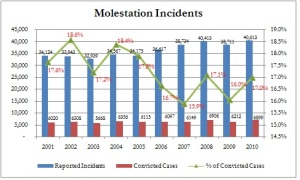
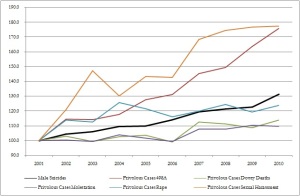
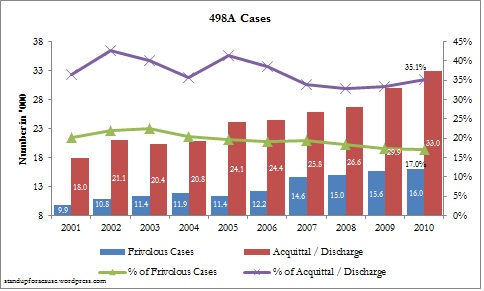
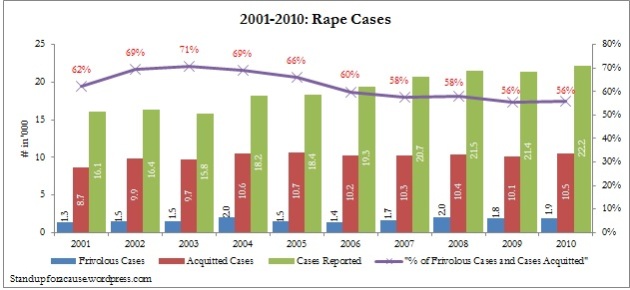



Comments